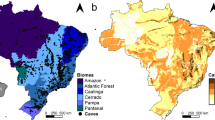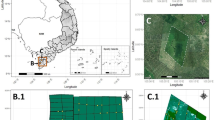Abstract
The model organism Drosophila has been used in several areas of biology, and recent studies have suggested the potential of the Family Drosophilidae as an environmental bioindicator. However, the diversity of the family is poorly known, especially in certain environments such as the Restinga, a Brazilian lowland coastal environment. Given this, the main objective of this study was to evaluate the Drosophilidae biodiversity in the Itapeva State Park, in the municipality of Torres, Rio Grande do Sul, Brazil, in different seasons. Although the park is in a conservation unit, there are agricultural and pastoral activities in the area. We made seasonal samplings in 2013 using banana bait traps. Summer and Spring were the seasons with higher abundance, whereas Autumn was the richest. There was a predominance of exotic species, especially during Summer and Spring, and Drosophila simulans and Zaprionus indianus were the main representatives. Our study shows that Itapeva State Park biodiversity is comparable to other restinga surveys. The Itapeva State Park is in an intermediate state of conservation, and our results suggest that the urbanization within the park is possibly affecting the biodiversity, and the massive presence of exotic species may lead to biotic homogenization and loss of endemic species.





Similar content being viewed by others
References
Amaral O (2004) Biodiversidade e sazonalidade de drosofilídeos na estação ecológica de Paulo de Faria/SP. Universidade Estadual Paulista, Thesis
Araujo DSD, Lacerda LD (1987) A natureza das restingas. CiÊncia Hoje 6(33):42–48
Azevedo MA, VA VA (2016) Fishes from Parque Estadual de Itapeva, Rio Grande do Sul state, Atlantic Forest biome, Brazil. Check List 12(4):1950
Bächli G, Vilela CR, Andersson S, Saura A (2004) The Drosophilidae (Diptera) of Fennoscandia and Denmark. (Fauna Entomologica Scandinavica, v 39). Brill, Boston
Bellaver J, Iserhard CA, Santos JP, Silva AK, Torres M, Siewert RR, Moser A, Romanowski HP (2012) Borboletas (Lepidoptera: Papilionoidea e Hesperioidea) de Matas Paludosas eMatas de Restinga da Planície Costeira da região Sul do Brasil. Biota Neotrop 12(4):181–190
Bernardo-Silva J, Martins-Ferreira C, Maneyro R, Freitas TRO (2012) Identification of priority areas for conservation of two endangered parapatric species of red-bellied toads using ecological niche models and hotspot analysis. Nat Cons 10(12):207–213
Bizzo L, Gottschalk MS, De Toni DC, Hofmann PRP (2010) Seasonal dynamics of a drosophilid (Diptera) assemblage and its potential as bioindicator in open environments. Iheringia Ser Zool 100:185–191
Bonorino CBC, Valente VLS (1989) studies on wild and urban populations and breeding sites of Drosophila nebulosa. Rev Bras Biol 49(3):771–776
Castro FL, Valente VLS (2001) Zaprionus indianus is invading Drosophila communities in the Southern Brazil city of Porto Alegre. Dros Inf Serv 84:15–17
Cavasini R, Buschini MLT, Machado LBP, Matheus RP (2014) Comparison of Drosophilidae (Diptera) assemblages from two highland Araucaria Forest fragments, with and without environmental conservation policies. Braz J Biol 74(4):761–768
Cerqueira R (2000) Biogeografia das restingas. In: Esteves FA, Lacerda LD (eds) Ecologia de restingas e lagoas costeiras. Núcleo de pesquisas ecológicas de Macaé, Rio de Janeiro, pp 65–76
Colombo P, Kindel A, Vinciprova G, Krause L (2008) Composição e ameaças à conservação dos anfíbios anuros do Parque Estadual de Itapeva, município de Torres, Rio Grande do Sul. Brasil Biota Neot 8(3):229–240
Cristo SSV, Gruber NLS (2011) Expansão urbana e os conflitos de uso do solo em ambientes fragilizados do litoral norte do Rio Grande do Sul. Para Onde!? 3:1–14
De Toni DC, Gottschalk MS, Cordeiro J, Hofmann PRP, Valente VLS (2007) Study of de Drosophilidae (Diptera) communities on Atlantic Forest islands of Santa Catarina State, Brazil. Neotrop Entomol 36:356–375
Deprá M, Poppe JL, Schmitz HJ, De Toni DC, Valente VLS (2014) The first records of the invasive pest Drosophila suzukii in South American Continent. J Pest Sci 87:379–383
Duarte MM, Bencke GA (2006) Plano de Manejo do Parque Estadual de Itapeva. http://www.sema.rs.gov.br/. Accessed 24 Jun 2019
Ferreira LB, Tidon R (2005) Colonizing potential of Drosophilidae (Insecta, Diptera) in environments with different grades of urbanization. Biodivers Conserv 14:1809–1821
Garcia CF, Hochmüller CJC, Valente VLS, Schmitz HJ (2012) Drosophilid assemblages at different urbanization levels in the city of Porto Alegre, State of Rio Grande do Sul, Southern Brazil. Neotrop Entomol 41:1–12
Gomes VSM, Loiselle BA, Alves MAS (2008) Birds foraging for fruits and insects in shrubby restinga vegetation, southeastern Brazil. Biota Neotr 8(4):21–31
Goñi B, Martínez ME, Daguer P (1997) Studies of two Drosophila (Diptera, Drosophilidae) communities from urban Montevideo, Uruguay. Revista Brasileira de Entomologia 41:89–93
Gottschalk MS, De Toni DC, Valente VL, Hofmann PRP (2007) Changes in Brazilian Drosophilidae (Diptera) assemblages across an urbanization gradient. Neotrop Entomol 36:848–862
Gruber NLS, Barboza EG, Nicolodi JR (2003) Geografia dos Sistemas Costeiros e Oceanográficos: Subsídios para Gestão Integrada da Zona Costeira. Gravel, Porto Alegre
Hernández MIM, Barreto PSCS, Costa VH, Creão-Duarte AJ, Favila ME (2014) J Insect Cons 18:543–546
Inoue YH, Taira T, Yamamoto M (1988) Genetics of an unstable white mutation in Drosophila simulans: reversion, suppression and somatic instability. Genetics 119:903–912
Hochmüler CJ, Lopes-da-Silva M, Valente VLS, Schmitz HJ (2010) The drosophilid fauna (Diptera, Drosophilidae) of the transition between the Pampa and Atlantic Forest Biomes in the state of Rio Grande do Sul, southern Brazil: first records. Pap Avulsos Zool 50:285–295
Maia VC, Silva SO (2016) Insect galls of Restinga de Marambaia (Barra de Guaratiba, Rio de Janeiro, RJ). Braz J Biol 76(3):787–795
Martins MB (1996) Drosófilas e outros insetos associados a frutos de Parahancornia amapa disperso sobre o solo da floresta. Universidade Estadual de Campinas, Thesis
Martins MB (2001) Drosophilid fruit-fly guilds in forest fragments. In: Dierregaard Jr RO, Gascon C, Lovejoy TE, Mesquita R (eds) Lessons from Amazonia: the ecology and conservation of a fragmented forest. Yale University Press, New Haven, pp 175–186
Mata RA, Roque F, Tidon R (2008) Drosophilids (Insecta: Diptera) of the Parana Valley: eight new records for the Cerrado biome. Biota Neotrop 8:55–60
Melo AS (2008) O que ganhamos ‘confundindo’ riqueza de espécies e equabilidade em um índice de diversidade? [What do we win ‘confounding’ species richness and evenness in a diversity index?]. Biota Neotropica 8:21–27
Mendes MF et al (2017) Diversity of Drosophilidae (Insecta, Diptera) in the Restinga forest of southern Brazil. Rev Bras Entomol 63:248–256
Oksanen J, Blanchet FG, Friendly M, Kindt R, Legendre P, McGlinn D, Minchin PR, O’Hara RB, Simpson GL, Solymos P, Stevens MHM, Szoecs E, Wagner E (2019) vegan: Community Ecology Package. R package version 2.5–6. https://CRAN.R-project.org/package=vegan
Oliveira EA, Zardo CML, Nascimento LV (2006) Abundance and Seasonal pattern of the Insect fauna in a estuarine sandbank island in Lagoon Lagoa dos Patos, Rio Grande, RS. Brazil Est Biol 28(64):27–35
Penariol L, Bicudo HEMC, Madi-Ravazzi L (2008) On the use of open or closed traps in the capture of drosophilids. Biota Neotrop 8:47–51
Penariol LV (2012) Traços quantitativos e abundância de drosofilídeos como indicadores de impacto ambiental em fragmentos de floresta estacional semidecidual. Universidade Estadual Paulista, Thesis
Poppe JL, Valente VLS, Schmitz HJ (2012) Structure of Drosophilidae assemblage (Insecta, Diptera) in Pampa Biome (São Luiz Gonzaga, RS). Pap Avulsos Zool 52:185–195
RStudio Team (2020) RStudio: Integrated Development for R. RStudio, PBC, Boston, MA. http://www.rstudio.com/
Saavedra CCR, Callegari-Jacques SM, Napp M, Valente VLS (1995) A descriptive and analytical study of four neotropical drosophilid communities. J Zool Sys Evol Res 33:62–74
Santos RA, Valente VLS (1990) on the occurrence of Drosophila paulistorum dobzhansky & pavan (diptera, drosophilidae) in an urban environment: ecological and cytological observations. Evol Biol 4:253–268
Scarano FR (2002) Structure, function and floristic relationships of plant communities in stressful habitats to the brazilian atlantic rainforest. Ann Bot 90:517–524
Schmitz HJ, Hofmann PRP, Valente VLS (2010) Assemblages of drosophilid (Diptera, Drosophilidae) in mangrove forests: community ecology and species diversity. Iheringia Ser Zool 100:133–140
Sene FM, Val FC, Vilela CR, Pereira MAQR (1980) Preliminary data on the geographical distribution of Drosophila species within morphoclimatic domains of Brazil. Pap Avulsos Zool 33:315–326
Silva NM, Fantinel CC, Valente VLS, Valiati VH (2005) Ecology and populations dynamics of the invasive species Zaprionus indianus (Gupta) (Diptera: Drosophilidae) on the composition of the drosophilid communities in PortoAlegre city, Southern of Brazil. Neotrop Entomol 34:363–374
Tidon R, Leite DF, Leão BFD (2003) Impact of the colonization of Zaprionus (Diptera, Drosophilidae) in different ecosystems of the Neotropical region: 2 years after the invasion. Biol Conserv 112:299–305
Tidon R, Sene FM (1988) A trap that retains and keeps Drosophila alive. Dros Inf Serv 67:90
Torres FR, Madi-Ravazzi L (2006) Seasonal variation in natural populations of Drosophila spp (Diptera) in two woodland in the state of São Paulo, Brazil. Iheringia Ser Zool 96:437–444
Valente VLS, Araújo AM (1986) Comments on breeding sites of Drosophila willistoni Sturtevant (Diptera, Drosophilidade). Rev Bras Entomol 30(2):281–286
Valente VLS, Ruscyka SRA, Bonorino CBC, Brum BEP, Regner L, Morales NB (1989) Genetic and ecological studies on urban and marginal populations of Drosophila in the south of Brazil. Evol Biol 3:19–35
Valiati VH, Valente VLS (1997) Chromosomal polymorphism in urban populations of Drosophila paulistorum. Braz J Genet 20:567–581
Waechter JL (1985) Aspectos ecológicos da vegetação de restinga no Rio Grande do Sul, Brasil. Comunicação do Museu de Ciências da Pontifícia Universidade Católica do Rio Grande do Sul, Série Botânica 49–68
Wickham H (2016) ggplot2: Elegant Graphics for Data Analysis. Springer-Verlag New York
Acknowledgements
We thank CNPq for the financial support. We also thank Ney Alexandre and Paula Dandara Berruti for the precious help with the collections.
Funding
Grant sponsor: Conselho Nacional de Desenvolvimento Científico e Tecnológico (CNPq) Grant number: CNPq 455101/2014–0 and PRONEX 16/0485–4.
Author information
Authors and Affiliations
Corresponding author
Ethics declarations
Conflict of interest
The authors declare that they have no conflict of interest.
Additional information
Publisher's Note
Springer Nature remains neutral with regard to jurisdictional claims in published maps and institutional affiliations.
Rights and permissions
Springer Nature or its licensor (e.g. a society or other partner) holds exclusive rights to this article under a publishing agreement with the author(s) or other rightsholder(s); author self-archiving of the accepted manuscript version of this article is solely governed by the terms of such publishing agreement and applicable law.
About this article
Cite this article
Alexandre, B.G., Poppe, J.L., Zanini, R. et al. The potential of using Drosophila as bioindicator in a restinga environment. Int J Trop Insect Sci 43, 677–687 (2023). https://doi.org/10.1007/s42690-023-00983-y
Received:
Accepted:
Published:
Issue Date:
DOI: https://doi.org/10.1007/s42690-023-00983-y




